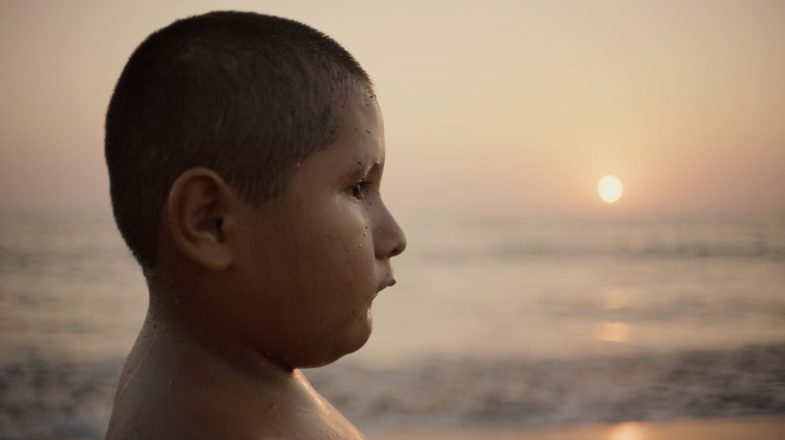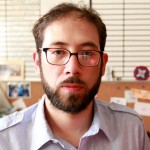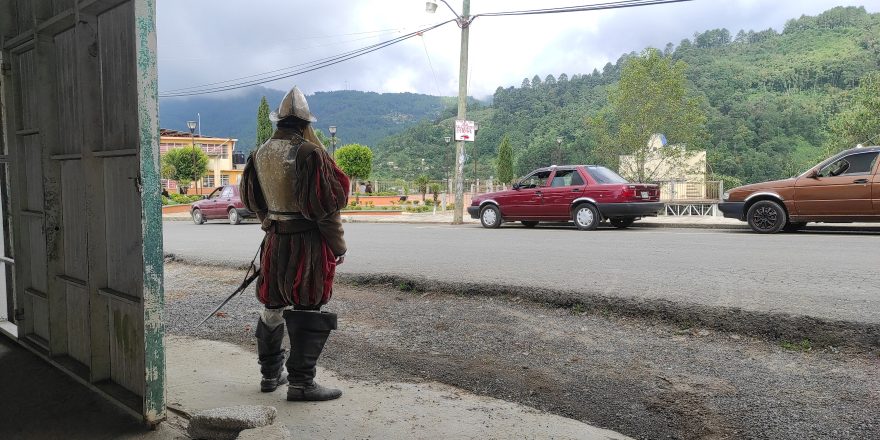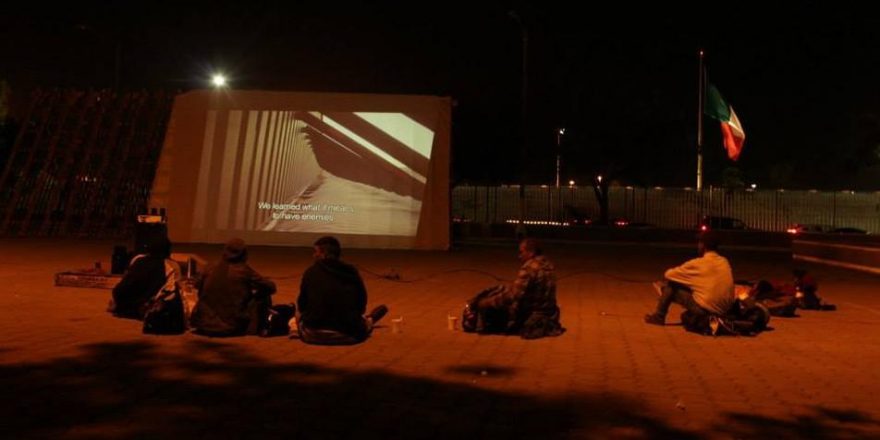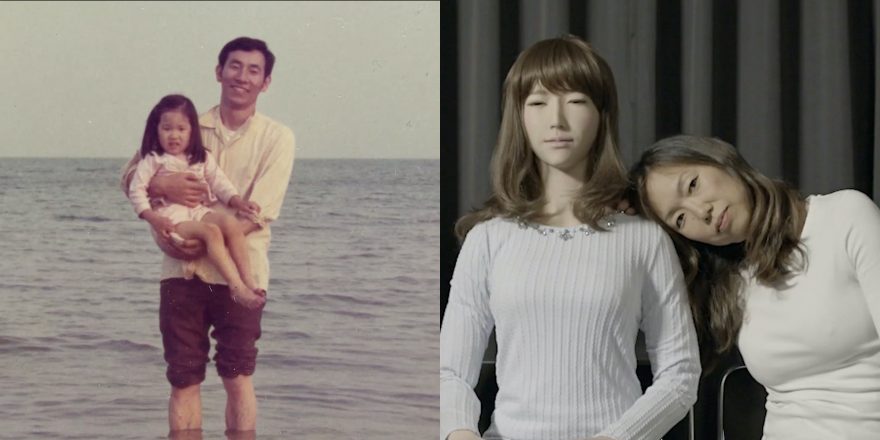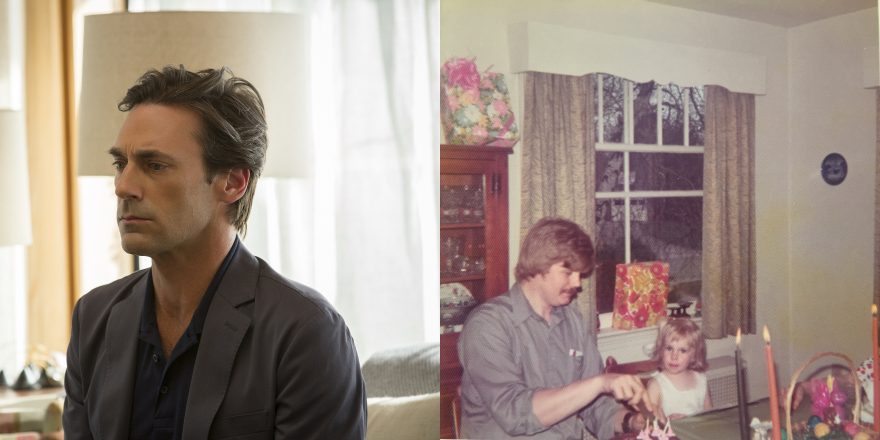Sansón and Me was born 10 years ago, after I met a young man who was on trial, facing a first-degree murder charge. I saw the action up close because I was his Spanish interpreter. Sitting just inches away, unable to have a conversation or break my role as an impartial officer of the court, I watched as his life careened into the brick wall we call the criminal justice system.
Found guilty and sentenced to life without parole, Sansón disappeared into the prison pipeline. But I could not forget him. This film tells the story of what happened after we connected, how our friendship blossomed and we tried to understand how a young Mexican boy could end up erased by both Mexico and the United States.
—-//—-
I am writing this because I’ve arrived at a milestone. After 10 years of work, my film Sansón and Me is opening in theaters. The moment is bittersweet, because my friend, the protagonist and heart of the story, remains incarcerated and has not been able to see his life in cinema.
The absence of closure, after sharing so much of yourself, is a terrible kind of violence. The film grapples with it directly, to the best of my ability.
But there were other violences in the course of this journey, experiences that remain unstated in the film itself. The imprints of these moments are still pinned to the walls of my creative mind. They sit in the half-light, brutal and stark, asking urgent questions about the life of my friend Sansón. Why are children surrounded by so much pain? Are some of us simply born into sweet delight, while others are condemned to endless nights? What is the real meaning of storytelling when we hold the trust of someone’s life in our work?
With time, I’ve learned to appreciate these questions, knowing they will follow me for many years, as I try to find their answers. This is the chronicle of a handful of moments that exist outside of Sansón and Me, yet nevertheless left a mark and made all the difference.
—-//—-
Bricks
The brickyard lay sprawling across the dusty vacant lot, squat pyramids popping up here and there, surrounded by crisp geometric lines with tiny rectangles drying in the sun. Dirt hung in the air, sluggish and thick, trying to smother the houses that sat along the edges of that dismal place.
The manager watched us with curiosity and caution. He was topless and wiry, as if he had been born and raised lugging bricks. Most importantly, the man was friendly. It had been surprisingly easy to convince him to let us film at the brickyard. I think he was not surprised at all by the idea of a child working there. In fact, I’m sure it was part of a normal day. So there we were, racing against the sunset, trying to shoot a small scene with Toñito, Sansón’s nephew, about a moment in Sansón’s own childhood.
My friend had written to me about the time after he became an orphan, when he had to earn his bread by working. In his letter, he shared a list of his labors, the life of a Mexican Oliver Twist: everything from washing passenger buses at the station to carrying a basket of fresh-baked bread on top of his head, while riding a bike. Sansón wanted to highlight the adventure and joy he felt as a child; but behind it all, he relayed a deep sadness and a sense of betrayal that had crept in as he grew up and understood just how wrong it was to have spent so much of his childhood hustling. Maybe this is why we settled on the brickyard, because there was something stark and painful about it that cut right to the heart of the conflict.
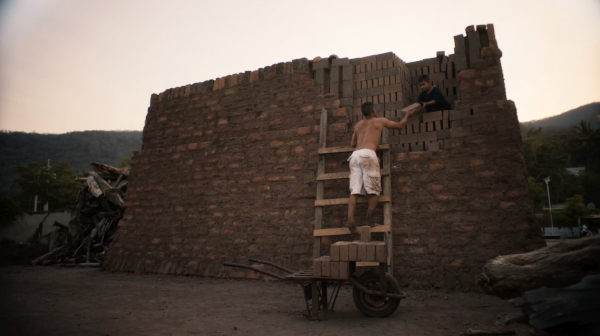
The scene is in Sansón and Me: the sun is setting and Toñito is on top of a stack of bricks, about two meters off the ground, carefully placing bricks ferried up to him by the limber manager. The bricks are heavy and Toñito soon grows tired. In the world of the film, the story keeps pushing forward and cuts to another job.
But in the so-called real world, as Toñito cleaned up and the crew broke down the set, the manager approached me with an anxious smile on his face and spat out a revelation — he’d been listening to us talk about the real kid behind the movie, and now he was absolutely sure. Many years ago, he had met Sansón himself, working in that very same brickyard.
This tiny anecdote is also violence. To be in the middle of the Pacific Coast, following the footsteps of your friend, and to find, 15 years later, his footprints still fresh in the dust.
—-//—-
A Little Girl
It was a hot, swampy morning in Tecomán, with a blistering sun promising no mercy for the rest of the day. The crew and I were all tired and emotionally hungover from the day before, when we had recreated the funeral of Sansón’s father, who died tragically when my friend was in first grade. The ceremony had gathered family, friends and neighbors inside a sweltering porch in his grandmother’s home, crowding a humble coffin wedged against a corner, holding the deceased, played stoically by Sansón’s beloved uncle Ramón. The scene is one of my favorites in the entire film, full of an electric, transcendent energy.
Right after the funeral, we shepherded the people into a wonderful block party, including a live band, free food and joyous dancing. We hoped to transmute mourning into celebration. These images are also very dear to me, and live within the film. In a sense, the day before had been a perfect shoot that captured the polar opposites of Sansón’s story, oscillating always between hope and tragedy.
And thus we returned the morning after, still processing these conflicting emotions. I know I was inside the house blocking off a scene, but I don’t remember what exactly we were trying to set up — it’s all just a jumbled, grinding fatigue. And it really doesn’t matter, because everything stopped once the truck pulled up, with the crying little girl riding in the open bed.
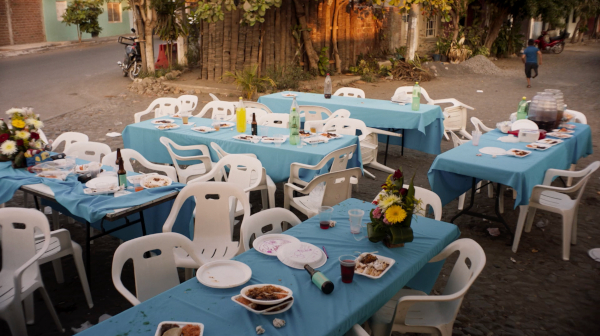
The man driving stepped out and started talking to my dear friend Chopa, our co-producer, who until then had always had a zen demeanor throughout the entire stormy production. But now he rushed towards me, a look of worry etched across his face — I had to talk to this man right away.
A little girl had gone missing without a trace, and she had been there with us, at the funeral shoot and the block party, the night before. The family wanted to be sure she was not there in the house, being forced to take part in some filthy movie. And yet the man was not accusatory or aggressive when he shared these horrors. It was as if the man and his relatives were sorry to interrupt us, and they felt embarrassed to ask for permission to inspect the location. It was the kind of wild clash of possibilities that happens in a war zone, where atrocities overwhelm our sense of reality.
Still dazed, I asked Chopa to call his contacts in local government and request a patrol car right away. We would do a walk-through, I assured the man, but only with a police escort. The minutes passed in a fog of worried looks and unspoken words. And all the while, the little girl in the truck, the sister of the missing child, stood there and cried, her small chest heaving softly.
Once the police arrived, we spent a handful of minutes walking around the house, room by room, after which the family left to continue their harrowing search. Kelsy Naomi Castañeda Córdoba went missing on Friday the 19th of May, 2017, in the city of Tecomán, State of Colima, Mexico, while she was on her way to the beach to sell donuts. To this day, she has never been found. She was eight years old.
—-//—-
Visiting Day
Pelican Bay State Prison is a cold, miserable, silent place. It’s wedged deep in the northernmost corner of California, surrounded by a gray rain that cuts right into you. The prison is part of a massive corridor stretching across rural, impoverished California, a network where the promise of a huge employer delivering economic development becomes intertwined with the brutality of mass incarceration.
Years ago, in the midst of the journey of making this film, I traveled often to this sorrowful place to visit my friend. Sansón had been moved here from the center of the state, eight hours away from his family through winding single-lane roads. Isolation and distance were, of course, the whole point. And on top of all this, Sansón was being held in solitary, a prison inside the prison, encased in layers of reinforced concrete.
I remember the events of one particular morning, the first time I visited with Su Kim, my unconditional friend, collaborator and fearless producer — the only person aside from myself to ever visit Sansón for this film.
We were in the lobby of the security checkpoint, waiting our turn in a Kafka-esque process, as a room full of exhausted travelers tried to survive an absurd chess game in order to see our person. Some folks had driven all night from SoCal with a carful of kids and grandparents. Others were women who had partners inside, trying their best to look beautiful without crossing the nebulous line drawn by the authorities, separating tasteful from provocative. As we waited for the gears of the system to get going, folks would sneak looks at us, wondering what the hell we were doing there. Everyone was clearly there to see a loved one or a family member, except for us.
Our turn came and we lined up to cross a huge metal detector dialed way past the limits of safe radiation. It was so sensitive that buttons would send it wailing, forcing everyone to walk through the portal in extreme slow-motion, zombie-like, under the watchful, bored gaze of prison guards wrapped in khaki-colored uniforms, girded with heavy leather belts carrying handcuffs and pepper-spray.
We stepped into a security well with 40 feet of cyclone fencing around us, and soon found ourselves in our designated visitors room. Imagine a wide kindergarten classroom with floor-to-ceiling windows on one side, covered in blue walls with boardgames and colorful posters scattered about. The room was covered by a grid of squat, circular tables, pressed close to the ground and surrounded by adult-size formica chairs, as if the room had been adapted for adults at the last minute.
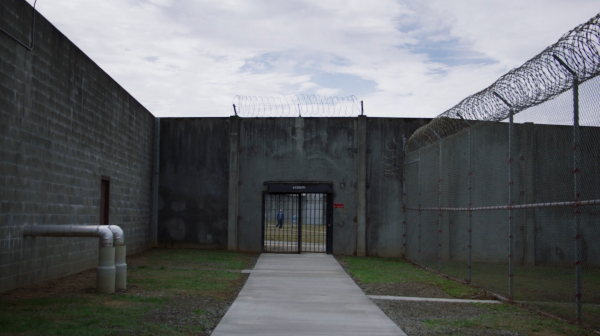
Su and I sat at our assigned spot, facing each other on opposite sides of the table, with an empty chair sitting in the gap between us. This was to be Sansón’s when he arrived. It was set in such a way that a guard sitting in a station at the top of the room could always see Sansón’s full profile, just in case we tried to pass him any contraband. We took in the aseptic silence, the shimmering black orbs of security cameras hung from the ceiling, the muffled echoes of voices bubbling out from deep inside the bowels of the prison, until a bolt clicked in a far corner, followed by the opening of a thick metal door. There they were, lined up against a wall. Their faces were caught in a contradiction between staying tough and yelling out their joy at seeing their visitors. Sansón softened his look, smiled with grace and tipped his head at us.
One by one, the prisoners moved along the perimeter of the room and to their assigned tables. When Sansón approached, we each gave him the one hug the rules allowed at the start of our time together, a movement echoed awkwardly across the others in the room. We began to stumble through the opening chitchat, the bizarre ritual of asking someone inside a maximum-security prison, “How are you? How’s it going?” Slowly, though, the barriers of the system gave way as our conversation started flowing. Sansón wanted to try speaking English with Su, and I interpreted bits and pieces for her, filling in the blanks. We ate popcorn and chimichangas procured from a block of vending machines in the corner, as we talked about the film, Sansón’s hopes for the project and his future, his thoughts on his family and his only son.
Suddenly, the guard in the station stood up and said something loudly, a code word or a command, and all the inmates stood up in one motion, including Sansón, and lined up with their backs against the far wall. It was time for the bathroom break. I looked around the room and noticed that everyone was reeling, trying to not let the interruption break the magic. We had all been in the midst of sharing some anecdote from life — a birthday, an adventure at school or a gathering, a reflection on a piece of news, all sorts of wonderfully normal things. It felt like we had come to a sudden halt in the midst of a sprint. The authority of the prison had imposed itself on us, reminding us who was in charge.
We watched as the men in line slowly took turns going in and out of the toilet, only to line up again on the opposite side of the bathroom door. There was something mechanical and terribly sad about it, something disturbing and painful, like watching a beautiful animal locked up in a zoo and knowing, instantly, it is deeply wrong. Almost all of them were black and brown men, and in most, there was a shadow of the kid that once ran free. He was there like a swift glimmer of energy, hiding behind the faces and gestures of these men who had to learn to survive in hell.
Sansón returned and we stepped out into a barren, gray yard surrounded by a tall cinder-block perimeter and occupied by a couple of concrete picnic tables. The rules said we could walk in circles or sit, so we walked side by side and looked at the blurry clouds in the sky, trying to make the most of the few hours we had left. We then stepped back inside and took a photo together, in front of a painting of sea life drawn from the imagination of a fellow inmate. An in-house photographer framed us into the only authorized composition and captured the only image allowed for us that day.
When the time came to say goodbye, we used up our last hug, and Sansón smiled and thanked us in his trademark sincere and respectful way. Su and I were feeling dismayed at the prospect of leaving and not knowing when we would see him again. The moment was flooded with sadness and then shame, because Sansón was still there, brave and smiling, his chin held high, his eyes seeing far deeper than ours. Who was this man who could smile in the middle of such a goodbye?
—-//—-
There are things that are impossible to film and yet are part of the soul of a film.
Sansón and I have talked about these encounters with violence many times over the years, in writing, on the phone and during in-person visits; yet their imprint is still there, marked on the skin of our relationship. While Sansón will finally watch the film in September, thanks to public television and the good folks at Independent Lens, the questions posed by these experiences still hang heavy in the air.
I know I did not find all the answers with this film. At best, I was able to catch aspects of the true essence of what Sansón has lived through. But I feel at peace knowing our friendship was our compass. We listened, we shared, we argued and talked it through, and tried our best to take care of each other. Most importantly, we worked to share our struggles with you all, in the hopes that you will sense the beautiful, honest and tenacious spirit behind this story.
Cinema is the art of remembering with light. There’s something about the screen that holds the magic of memory. Yet we makers, as we bring our stories to life, are also forced to sort through what we have seen, elevating some moments, suppressing others, and shaping it all into a story we can share, full of images that can grow like seeds inside the hearts of others. In our craft, story is just a tool, a way of expressing something essential in the world that is just beyond our grasp.


